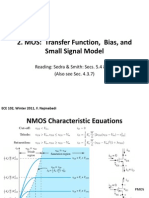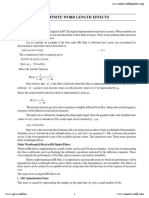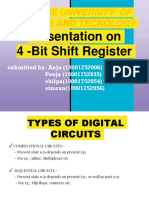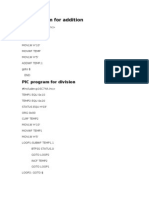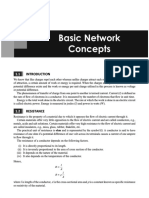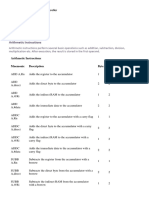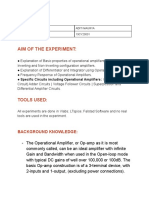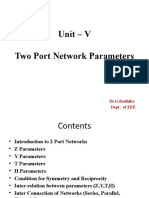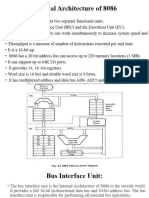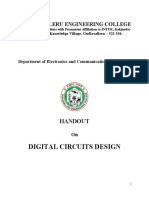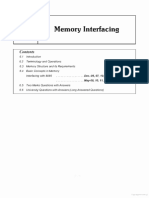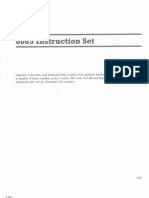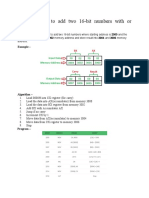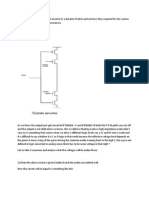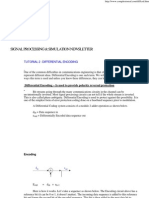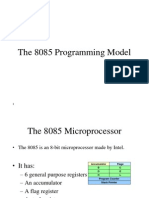0 ratings0% found this document useful (0 votes)
722 views24 pagesInstruction Classification Unit 2
Uploaded by
shivangi sharmaCopyright
© © All Rights Reserved
We take content rights seriously. If you suspect this is your content, claim it here.
Available Formats
Download as PDF or read online on Scribd
0 ratings0% found this document useful (0 votes)
722 views24 pagesInstruction Classification Unit 2
Uploaded by
shivangi sharmaCopyright
© © All Rights Reserved
We take content rights seriously. If you suspect this is your content, claim it here.
Available Formats
Download as PDF or read online on Scribd
You are on page 1/ 24
INSTRUCTION CLASSIFICATION
An instruction is a binary pattern designed inside a microprocessor to perform a specific
function. The entire group of instructions, called the instruction set, determines what
/ functions the microprocessor can perform. The 8085 microprocessor includes the instruc-
tion set of its predecessor, the 8080A, plus two additional instructions.
5.21 The 8085 Instruction Set
The 80835 instructions can be classified into the following five functional categories: data
transfer (copy) operations, arithmetic operations, logical operations, branching opera-
tions, and machine-control operations.
Scanned with CamScanner
DATA TRANSFER (COPY) OPERATIONS ae
This group of instructions copies data from a location called a source to another locati on
called ination, without 'ying the contents of the source. In technical manuals,
the term data transfer is used for this copying function. However, the term transfer is
\\ Disteading it creates the impression that the contents of a source are destroyed when, in
fact, the contents are retained without any modification. The various types of data trans-
fer (copy) are listed below together with examples of each type:
. Types Examples
O Between registers Copy the contents of register B into register D.
O Specific data byte to a Teg- Load register B with the data byte 32H.
ister or a memory location
O Between a memory loéation From the memory location 2000H to register B.
and a register
O Between an I/O device and From an input keyboard to the accumulator.
the accumulator
ARITHMETIC OPERATIONS
These instructions perform arithmetic operations such as addition, subtraction, increment,
and decrement.
5 Addition ZAny 8-bit number, or the contents of a register, or the contents of a mem-
ory location can be added to the contents of the accumulator and the sum is stored in
the accumulator) No two other 8-bit registers can be added directly (e.g., the contents
of register B Cannot be added directly to the contents of register C). The instruction
DAD is an exception; it adds 16-bit data directly in register pairs,
a Subtraction (Any 8-bit number, or the contents of a register, or the contents of a
memory location can be subtracted from the contents of the accumulator and the re.
sults stored in the accumulator) The subtraction is
the results, if negative, are expressed in 2’s com
subtracted directly.
5 Increment/Decrement—The 8-bit contents of a register or a memory location can be
incremented or decremented by 1. Similarly, the’16-bit contents of a tegister pair (such
as BC) can be incremented or decremented by 1. These i ement and decrement op-
rations differ from addition and subtraction in an important way rey
formed in-any one of the regi ters or in a memory location,
Performed in 2's complement, and
plement. No two other Tegisters can be
.e., they can be per-
~” LOGICAL OPERATIONS.
These instructions -perform various logical operations with the contents of the accumu
lator.”
G-AND, OR, Exclusive-OR—Any 8-bit number, or
memory location‘c;
the contents of a regi
_ Of the accumulator,
. be logically ANDed, ORed, or Exclusive-O)
‘The results are stored in the accumulator. a
or of a
with the contents
Scanned with CamScanner
}O-
er left or right to the next p
ifted eith
4 Rotate—Each bit in the accumulator can be shifted
ister,
ith the content
a memory Jocation can
2 ts of the accumu-
it number, or the contents of a reg}
~Any 8- i
ty, greater than, or less than, Wi
be compared for equa
lator, nite
ator. ompleme!
& Complement—rhe contents of the accumulator can be comp!
placed by Is and all 1s are replaced by 0s.
d; all Os are re-
BRANCHING OPERATIONS ion either conditionally
This group of instructions alters the sequence of program execution
or unconditionally,
& Jump—Conditional jumps are an important aspect of the decision-making process ip
Programming, These instructions test for a certain condition (e.g., Zero or Carry flag
and alter the program sequence when the condition is met. In addition, the instruction
Set includes an instruction called unconditional jump. .
O Call, Return, and Restart—These instructions change the sequence of a program ei-
ther by calling a subroutine or returning from a subroutine. The conditional Call and
Return instructions also can test condition flags.
“ MACHINE CONTROL OPERATIONS
‘These instructions control machine functions such as Halt, Interrupt, or do nothing.
5.22 Review of the 8085 Operations
The microprocessor operations related to data manipulation can be summarized in four
functions:
1. copying data
2. performing arithmetic operations
3. performing logical operations
4. testing for a given condition and altering the program sequence
Some important aspects of the instruction set are noted below:
1, In data transfer, the contents of the source are not destroyed; only the contents of
destination are changed. The data copy instructions do not affect the fla, sents of the
2. Arithmetic and logical operations are performed with the contents of the,
and the results are stored in the accumulator (with some exceptions). The £1
fected according to the results,
3. Any.register including memory can be used for increment and decrement,
4. A program sequence can be changed either conditional .
condition. ahs
lly or by testing for a given data
Scanned with CamScanner
~~ MUN 1U U8 ASSEMBLY LANGUAGE PROGKAMINNS
Mnemonics A ” & fetteny fe Sugyet me op” & synod
~ INSTRUCTION AND DATA FORMAT
INSTRUCTION AND OO
An instruction is a command to the microprocessor to perform a given task on specified
data. Each instruction has two parts: one is the task to be performed, called the operation
code (opcode), and the second is the data to be operated on, called the operand. The
operand (or data) can be specified in various ways. It may include 8-bit (or 16-bit) data,
an internal register, a memory location, or an 8-bit (or 16-bit) address. In some instruc-
tions, the operand is implicit.
5.31 Instruction Word Size
The 8085 instruction set is classified into the following three groups according to word
size:
1. One-word or 1-byte instructions
2. Two-word or 2-byte instructions
3. Three-word or 3-byte instructions
In the 8085, “byte” and “word” are synonymous because it is an 8-bit micro-
processor. However, instructions are commonly referred to in terms of bytes rather than
words.
ONE-BYTE INSTRUCTIONS
‘A L-byte instruction includes the opcode and the operand in the same byte. For example:
Task Opcode Operand* Binary Code Hex Code
Copy the contents of MOV CA 0100 1111 4FH
the accumulator in =
register C.
Add the contents of ADD B 1000 0000 80H |
register B to the i
contents of the ac-
cumulator.
Invert (complement) CMA 0010 Hh oFH
each bit in the ac- ah
cumulator.
: These instructions are 1-byte instructions performing three different tasks. In the
first instruction, both operand registers~are specified. In the second instruction, the
operand B is specified and the accumulator is assumed. Similarly, in the ;
third instruction,
*In the operand, the destination register C is shown first, followed by the source register A.
egister
Scanned with CamScanner
PROGRAMMING THE 2086
it operand, ‘These instructions are stored in B-
it operand. Thes
the accumulator is assumed to be the implici ry location.
bit binary format in memory; cach requires one memo!
TWO-BYTE INSTRUCTIONS
In a 2-byte instruction, the first byte specifies the 0)
specifies the operand, For example:
peration code and the second byte
Hex
Task Opcode Operand —_Binary Code Code
Load an 8-bit MVI A,Data 0011 1110 3E First es :
data byte DATA Data Second Byte
in the ac- i)
cumulator.
Assume the data byte is 32H. The assembly language instruction is written as
Mnemonics Hex Code
MVIA,32H 3E 32H
This instruction would require two memory locations to store in memory.
THREE-BYTE INSTRUCTIONS
In a 3-byte instruction, the first byte specifies the opcode, and the following two bytes
specify the 16-bit address. Note that the second byte is the low-order address and the third
byte is the high-order address. For example: 5
Hex
Task Opcode Operand —Binary Code _—Code
Transfer the JMP 2085H 1100 0011 C3* First Byte
program 1100 0011 85 Second Byte
sequence (0010-0000 20 Third Byte
to the .
memory
location
2085H.
This instruction would require three memory locations to store in memory.
These commands are in many ways similar to our everyday conversation, For ex-
ample, while eating in a restaurant, we may make the following requests and orders
1, Pass (the) butter.
Pass (the) bowl.
Scanned with CamScanner
HOW TO WRITE, ASSEMBLE, AND EXECUTE
A SIMPLE PROGRAM
i rm a specific
A program is a sequence of instructions written to tell a computer to perfo: pet
function. The instructions are selected from the instruction set of the ee een ~
write a program, divide a given problem in small steps in terms of the oper:
can perform, then translate these steps into instructions.
adding two numbers in the 8085 language is illustrated below.
5.41 Illustrative Program: Adding Two Hexadecimal Numbers
Writing a simple program of
PROBLEM STATEMENT : :
Write instructions to load the two hexadecimal numbers 32H and 48H in registers A and
B, respectively. Add the numbers, and display the sum af the LED output port PORT1.
PROBLEM ANALYSIS
Even though this is a simple problem, it is necessary to divide the problem into small
Steps to examine the process of writing programs. The wording of the problem provides
sufficient clues for the necessary steps. They are as follows:
1. Load the numbers in the registers.
2. Add the numbers:
3. Display the sum at the output port PORT1.
FLOWCHART
The steps listed in the problem analysis and the sequence‘can be Tepresented in a block
diagram, called a flowchart. Figure 5.2 shows such a flowchart Tepresenting the above
steps. This is a simple flowchart, and the steps are self-explanatory. We will discuss flow.
charting in the next chapter. ”
ASSEMBLY LANGUAGE PROGRAM
To write an assembly language program, we need to translate
flowchart into 8085 operations and then, subsequently,
the blocks, we can classify them into three types of opel
operations; Block 2 is an arithmetic operation; and Bl
tion. To translate these steps into assembly and machi
the instruction set. The translation of each block in
shown as follows: soe
a the blocks shown in the
into mnemonics. By examining
ations: Blocks 1 and 3 are copy
lock 4 is a machine-control opera-
ine languages, you should review
to mnemonics with comments is
Scanned with CamScanner
INTRODUCT;
ION
70 8088 ASSEMBLY LANGUAGE PROGRAMM
ING
FIGURE 5.2
Flowchart: Adding Two Numbers
Block 1;
Block 2:
Block 3:
Block 4:
MVIA,32H
MVIB,48H
ADD B
OUT O1H
HALT
Display |
Sum
Load register A with 32H
Load register B with 48H
‘Add two bytes and save the sum in A
Display accumulator contents at port 01H
End
FROM ASSEMBLY LANGUAGE TO HEX CODE
To convert the mnemonics into Hex code, we need to look up the code in the 8085 in-
struction set; this is called either manual or hand assembly.
Mnemonics
MVIA,32H
MVI B,48H
ADD B
OUT 01H
HLT
Hex Code
3E
32.
06
48
80
D3
O1
16
2-byte instruction
2-byte instruction
{-byte instruction
2-byte instruction
I-byte instruction
STORING IN MEMORY AND CONVERTING FROM HEX
CODE TO BINARY CODE
To store the program in RW
output, we need to know the
memory of a single-board microcomputer and display Ue
memory addresses and the output port address, Let us a
151
Joes
Scanned with CamScanner
sume that R/W memory ranges from 2000H to 20FFH, and the system has an LED out-
put port with the address 01H. Now, to enter the program:
1. Reset the system by pushing the RESET key.
2. Enter the first memory address using Hex keys where the program should be stored.
Let us assume it is 2000H
3. Enter each machine code by pushing Hex keys. For example, to enter the first machine
code, push the 3, E, and STORE keys. (The STORE key may be labeled differently in
different systems.) When you push the STORE key, the program will store the ma
chine code in memory location 2000H and upgrade the memory address to 2001H.
4. Repeat Step 3 until the last machine code, 76H.
5. Reset the system.
Now the question is: How docs the Hex code get converted into binary code? The
answer lies with the Monitor program stored in Read-Only memory (or EPROM) of the
microcomputer system. An important function of the Monitor program is to check the
keys and convert Hex code into binary code, The entire process of manual assembly is
shown in Figure 5.3.
In this illustrative example, the program will be stored in memory as follows
Memory
Mnemonics Hex Code Memory Contents Address
MVIA32H 3E ool 2000
32 oo 1) 2001
MVIB,48H 06 0000 2002
48 0100 2003
ADD B 80 1000 2004
OUT 01H D3 110 2005
Ol 0000 2006
HLT 16 [ort 2007
This program has eight machine codes and will require eight memory locations to
store the program. The critical concept that needs to be emphasized here is that the mi
croprocessor can understand and execute only the binary instructions (or data): everything
else (mnemonics, Hex code, comments) is for the convenience of human beings
EXECUTING THE PROGRAM
To execute the program, we need to tell the microprocessor where the program beg
entering the memory address 2000H. Now, we can push the Execute key (or the key with,
a similar label) to begin the execution, As soon as the Execute function key is pushed, the
microprocessor foads 2000H in the pro,
ferred from the Monitor program to our program.
‘The microprocessor begins to rend one machine code ala time, and when it es
the complete instruction, executes that instruction, Hor example, i will fetch the ma-
ins by
M counter, and the program control is tans
Scanned with CamScanner
~_DBTA TRANSFER (COPY) OPERATIONS
One of the primary functions of the microprocessor is copying data, from a register (or
V/O or memory) called the source, to another register (or I/O or memory) called the des.
tination. In technical literature, the copying function is frequently labeled as the data
transfer function, which is somewhat misleading. In fact, the contents of the source are
not transferred, but are copied into the destination register without modifying the contents
of the source. :
Several instructions are used to copy data (as listed in Chapter 5). This section is
concerned with the following operations.
MOV : Move Copy a data byte.
MVI : Move Immediate Load a data byte directly.
OUT : Output to Port Send a data byte to an output device.
IN _ : Input from Port Read a data byte from an input device.
The term copy is equally valid for input/output functions because the contents of the
source are not altered. However, the term data transfer is used so commonly to indicate
the data copy function that, in this book, these terms are used interchangeably when the
meaning is not ambiguous.
In addition to data copy instructions, it is necessary to introduce two machine-
control operations to execute programs.
HLT: Halt Stop processing and wait,
NOP: No Operation _Do not perform any operation.
These operations (opcodes) are explained and illustrated below with examples.
INSTRUCTIONS
The data transfer instructions copy data from a source into a destination without
modifying the contents of the source. The previous contents of the destination are re-
placed by the contents of the source.
Scanned with CamScanner
INTRODUCTION TO 8085 INSTRUCTIONS
Vv
Important Note: In the 8085 processor, data transfer instructions do not affect the flags.
Opcode
MOV
Operand
RaRy
R8-bit
Brosh
8-bit port address
8-bit port address
‘The symbols Rd and Rs
Description
Move
O This is a 1-byte instruction
O Copies data from source register Rs to destina-
tion register Rd
Move Immediate,
0 This is a 2-byte instruction
1 Loads the 8 bits of the second byte into the
register specified :
Output to Port
C This is a 2-byte instruction
C Sends (copies) the contents of the accumulator
(A) to the output port specified in the second
byte
Input from Port
O This is a 2-byte instruction
© Accepts (reads) data from the input port speci-
fied in the second byte, and loads into the ac-
cumulator
Halt
CO This is a 1-byte instruction
1 The processor stops executing and enters wait
state
OO The address bus and data bus are placed in
high impedance state. No register contents are
affected
No Operation
1 This isa L-byte instruction
1 No operation is performed
O Generally used-to increase processing time or
substitute in place of an instruction. When an
error occurs in a program and an instruction
needs to be eliminated, it is more convenient
to substitute NOP than to reassemble the
whole program
generic terms; they represent any of the 8085 registers: A, B, C, D, E, H, and l-
3 ee
Scanned with CamScanner
ndicates hexadecimal num.
[Load the accumulator A with the data byte 82H (the Tettet H
ber), and save the data in register B.
Instructions — MVIA, 82H,
MOV B.A
i ie di y
The first instruction is a 2-byte instruction that loads the ae with | tn ao
82H, and the second instruction MOV B,A copies the contents of the acc 7
ister B without changing the contents of the accumulator.
Scanned with CamScanner
output ports with addresses trom UUH
! gic circuit (called interfacing)
used to cofinect and identify a port by the system designer (see Chapter 4)
s
6.11 Addressing Modes (): . ope
\ The’ above instructions are commands to the microprocessor to copy 8-bit data from a
Jaws into a destination. In these instructions, the source can be a register, an input port,
or an 8-bit number (00H to FFH). Similarly, a destination can be a register or an output
port. The sources and destination are, in fact, operands. The various formats of specify-
ing the operands are called the addressing modes. The 8085 instruction set has the fol-
lowing addressing modes. (Each mode is followed by an example and by the correspond-
ing piece of restaurant conversation from the analogy discussed in Chapter 5.)
1. Immediate Addressing—MVI R,Data (Pass the butter)
/2, Register Addressing—MOV Rd,Rs (Pass the bowl)
3. Direct Addressing—IN/OUT Port# (Combination number 17 on the menu)
4. Indirect Addressing—Illustrated in the next chapter (I will have what Susie has) “
(POU Ron LOG BY fF mUT mM wrt | AOD M aw 88
2 at
poy EL geet OPT comp oneal cose otf
Scanned with CamScanner
6.12 Iustrative Program: Data Transfer—From Register
to Output Port
PROBLEM STATEMENT
‘Load the hexadecimal number 37H in register B, and display the number at the output
port labeled PORT.
PROBLEM ANALYSIS
This problem is similar to the illustrative program discussed in Section 5.41. Even though
this is a very simple problem it is necessary to break the problem into small steps and to
outline the thinking process in terms of the tasks described in Section 6.1.
STEPS
Step 1: Load register B with a number.
Step 2: Send the number to the output port.
QUESTIONS TO BE ASKED
O Is there an instruction to load the register B? YES—MVI B.
O Is there an instruction to send the data from register B to the output port? NO. Review
the instruction OUT. This instruction sends data from the accumulator to an output port.
D The solution appears to be as follows: Copy the number from register B into accumu-
lator A. ; i
7 Is there an instruction to copy data from one register to another register? YES—MOV
RdRs.
Scanned with CamScanner
program in the next section.
ASSEMBLY LANGUAGE PROGRAM
Tasks 8085 Mnemonics
a5)
*
1. Load register B with 37H. oe
2. Copy the number from BA. ae
3. Send the number to the output—port O1H. iad
4. End of the program.
TRANSLATION FROM ASSEMBLY LANGUAGE TO MACHINE
LANGUAGE
Now, to translate the assembly language program into machine language, :
hexadecimal machine codes for each instruction in the 8085 instruction set and write each
machine code in the sequence, as follows: “
look up the
8085 Mnemonics Hex Machine Code
1. MVI B,37H 06
37
2. MOV A,B 78
3. OUT PORT1 D3
01
4, HLT 76
This program has six machine codes and will require six bytes of memory to enter
the program into your system. If your single-board microcomputer has R/W memory
starting at the address 2000H, this program can be entered in the memory locations
ae as The format generally used to write an assembly language program is
/ PROGRAM FORMAT
/ Memory — Machine
/ Address Code Instruction
(Hex) (Hex) Opcode Operand Comm
, ents
sie s MVI B,37H :Load register B with data 37H
*A number followed by the letter H represeqts a hexadecimal number.
+Enter high-order address (page number) of your R/W memory in place of XX
Scanned with CamScanner
INTRODUCTION TO 8085 INSTRUCTIONS
/
J; xx02 8 MOV AB {Copy (8) inte (A)
7 Xx03 D3 OUT PORTI “Display accumulator CONTENTS
xxo4 PORTI" < Q7H) at Port
XX05 76 HLT “End of the program
‘This program has five columns: Memory Address, Machine Code, Opeode,
fae and Comments. Each is described in the context of a single-board microconr
Scanned with CamScanner
INTRODUCTION TO 8085 INSTRUCTIONS 7 i | %
AReTHMATIS INST: AN
ADD: Add ‘Add the contents of a register."
ADI : Add Immediate Add 8-bit data. |
SUB : Subtract Subtract the contents of a register.
SUI : Subtract Immediate Subtract 8-bit data. ;
INR : Increment Increase the contents of a register by |.
DCR : Decrement Decrease the contents of a register by |.
are performed in relation to the contents of
The arithmetic operations Add and Subtract
n be performed
the accumulator. However, the Increment or the Decrement operations cai
in any register. The instructions for these operations are explained below.
INSTRUCTIONS
These arithmetic instructions (except INR and DCR)
1. assume implicitly that the accumulator is one of the operands.
2. modify all the flags according to the data conditions of the result.
3. place the result in the accumulator.
4. do not affect the contents of the operand register.
The instructions INR and DCR
1. affect the contents of the specified register.
2. affect all flags except the CY flag.
The descriptions of the instructions (including INR and DCR) are as follows:
Opcode Operand Description XK
ADD RT Add
: 0 This is a 1-byte instruction
O Adds the contents of register R to the contents of the ac-
_ cumulator
ADI _ Add Immediate
GF This is a 2-byte instruction
O Adds the second byte to the contents of the accumulator
SUB Rt ee hy
° isa l-byte instruction
acts the contents of register R from the contents of
SUI 8-bit
*Memory-related arithmetic operations are exclu
ete; they are discussed in ©
Scanned with CamScanner
PROGRAMMING THE 025
© Subtracts the second byte from the contents of the accu-
me a malator
Gi This is 2 1-byte instruction
© Increases the contents of register R by 1
Caution: All flags except the CY are affected
DcR R* Decrement
Gi This is 2 1-byte instruction
Decreases the contents of register R by 1
Caution: All flags except the CY are affected
6.21 Addition
The 8085 perfornis addition with &-bit binary numbers and stores the sum in the accu-
mutator. If the sum is larger than eight bits (FFH), it sets the Carry flag. Addition can be
performed either by adding the contents of a source register (B, C, D, E, H, L, or mem-
ory) to the contents of the accumulator (ADD) or by adding the second byte directly to
the contents of the eccumulator (ADI).
Scanned with CamScanner
{dd the number 35H directly to the sum in the previous example when the CY flag is set.
Instruction ADI 35H
cy
(A): 4AH= [1] 0100 1010
+
(Data) : 35H
(A): 7FH
OOL 0
O11 1
“ 1 101
0] 1 11it
Flag Status: S = 0,Z=0, CY =0
The addition of 4AH and 35H does not generate a carry and will reset the previous Carry
flag. Therefore, in adding numbers, it is necessary to count how many times the CY flag
is set by using some other programming techniques (see Section 7.32).
{a
Ex
Assume the accumulator holds the data byte FFH. Illustrate the differences in the flags set
by adding 01H and by incrementing the accumulator contents.
Instruction ADI 01H
cy
(A): FFH= 11111111
+
(ata) : OIH= 0000 0001
1111 1111 Cany
DUO)
(A) :Mo0H= [1 o000 0000
cy
Flag Status: S=0,Z=1,CY=1
After adding 01H to FFH, the sum in the accumulator is 0 with a carry. Therefore, the CY
and Z flags are set. The Sign flag is reset because D; is 0.
Instruction INRA
The accumulator contents will be OOH, the same as before, However, the instruction INR
Will not affect the Carry flag; it will remain in its previous status.
Flag Status: $= 0, Z=1,CY=NA
Ex
FLAG CONCEPTS AND CAUTIONS
AS described in the previous chapter, the flags are flip-flops that are set or reset after the
€xecution of arithmetic and logic operations, with some exceptions. In many ways, the
flags are like signs on an interstate highway that help drivers find their destinations
Scanned with CamScanner
6.22 Illustrative Program: Arithmetic Operations—Addition
At and Increment
PROBLEM STATEMENT
Write a program to perform the following functions, and verify the output.
1. Load the number 8BH in register D,
2, Load the number 6FH in register C.
3. Increment the contents of register C by one.
4, Add the contents of registers C and D and display the sum at the output PORT!
PROGRAM
The illustrative program for arithmetic operations using addition and increment is pr
sented as Figure 6.5 to show the register contents during some of the steps.
Scanned with CamScanner
Comments and
\ 7 Register Contents
Machine nd ine codes
Maree) Code Opeode Oper™ The first four machine co*
Joad the registers a
A
x00 16 mviD.8BH 4 ‘
a 8B
H
03 oF
Add O1 to (Cy: 6F + Ol = 70"
4 oc INR c
05 79 MOV .A.C
06 82 ADD DD
07 D3 OUT PORT!
08 PORT# — PORT!
0 6 HLT End of the program
IGURE 6.5
lustrative Program for Arithmetic Operations—Using Addition and Increm
. Instruction ADD D adds (1D) to (A), stores the sum in A,
and sets the Sign flag
shown below:
5h (A): 70H = OF ete 0:05010
+
(D) 8BH = 1000 1011
(A): FBH= ©} 111d 101 1 (ce re 6.5)
Gy,
Flag Status: S = 1,Z=0, CY =0
>. The sum FBH is disnlaved hw tha rrr
Scanned with CamScanner
Se
6.24 Illustrative Program: Subtraction of Two Unsigned Numbers
PROBLEM STATEMENT
Write a program to do the following:
1. Load the number 30H in register B and 39H in register C.
2. Subtract 39H from 30H.
3. Display the answer at PORTI.
PROGRAM
The illustrative program for subtraction of two unsigned numbers is presented as Figure
6.6 to show the register contents during some of the steps.
PROGRAM DESCRIPTION
1. Registers B and C are loaded with 30H and 39H, respectively. The instruction MOV
A.B copies 30H into the accumulator (shown as register contents). This is an essential
step because the contents of a register can be subtracted only from the contents of the
accumulator and not from any other register.
2. To execute the instruction SUB C the microprocessor performs the following steps in-
ternally:
Step 1: 39H =0011 1001
l’s complement of 39H = 1100 0110
+
Step 2: Add0l=0000 0001
2's complement of 39H = 1100 0111
+
Step 3: Add 30H to 2’s complement of 39H = 0011 0000
cy [0 Pili oll
Scanned with CamScanner
INTRODUCTION TO 8085 INSTRUCTIONS
Step 4: Complement carry T} tiii o1it
Flag Status: $= 1, Z=0, Cy =
3, The number F'7H is a 2's complement of the magnitude (39H — 30H) = 09H.
4, The instruction OUT displays F7H at PORT on OP
PROGRAM OUTPUT
This program will display F7H as the Output. In this program, the unsigned numbers were
used to perform the subtraction, Now, the question is: How do you recognize that the an-
swer F7H is really a 2°s complement of 09H and not a straight binary F7H?
The answer lies with the Carry flag, If the Carry flag (also known as the Borrow
flag in subtraction) is set, the answer is in 2's complement. The Carry flag raises a second
question: Why isn’t it a positive sum with a carry? The answer is implied by the instruc-
tion SUB (it is a subtraction),
There is no way to differentiate between a straight binary number and 2’s comple-
ment by examining the answer at the output port. The flags are internal and not easily dis-
Played. However, a programmer can test the Carry flag by using the instruction Jump On
Carry (JC) and can find a way to indicate that the answer is in 2's complement. (This is
discussed in Branch instructions.)
Memory Machine Instruction Comments and
Address (tt) Code Opcode —Operand Register Contents
HI-LO weet
Load the minuend in register B
axbo 06; Myl ao Load the subtrahend in register C
: oe ae, pe C208 The register contents:
03 39
4 8 MOV AB
aad 91 SUB c —
a 6 ‘63. OUT PORTI
O2.. PORT# .
8 76. HLT
FIGURE 6.6 ih ~
‘Wustrative Program for Subtraction of Two Unsigned Number
8.25 Review of Important Concepts
Scanned with CamScanner
LOGIC OPERATIONS
a Aiea ad
Wie is basically a programmable logic chip. It can perform all the logic
Aunctions of the hard-wired logic through its instruction set. The 8085 instruction set in-
/ cludes such logic functions as AND, OR, Ex OR, and NOT (complement). The opcodes,
/ of these operations are as follows:*
ANA: AND Logically AND the contents of a register,
AN AND Immediate Logically AND 8-bit data.
OR. OR Logically OR the contents of a register.
ORI : OR Immediate Logically OR 8-bit data.
X-OR Exclusive-OR the contents of a register.
X-OR Immediate Exclusive-OR 8-bit data.
All logic operations are performed in relation to the contents of the accumulator. The in-
structions of these logic operations are described below.
INSTRUCTIONS
The logic instructions
1. implicitly assume that the accumulator is one of the operands.
2. reset (clear) the CY flag. The instruction CMA is an exception;
flags.
3. modify the Z, P, and S flags according to the data conditions of the result,
4. place the result in the accumulator,
5. do not affect the contents of the operand register,
it does not affect ar
Scanned with CamScanner
INTRODUCTION TO 8085 INSTRUCTIONS
Opcode
ORA
* ORI
Operand
8-bit
Description
Logical AND with Accumulator =
Qo This is a 1-byte instruction
O Logically ANDs thé conteitts of the register R with the
Contents of the accumulator Sts—CS
8085: CY is reset and AC is set
AND Immediate with Accumulator
O'This is a 2-byte instruction”
O Logically ANDs the second byte with the contents of the
accumulator— ae rae fe >
0 8085: CY is reset and AC is set
Logically OR with Accumulator
C1 This is a 1-byte‘insfrtction’
D Logically ORs the contents of the register R with the
contents of the accumulator
OR Immediate with Accumulator
CO This is a 2-byte instruction
Ci Logically ORs the second byte with the contents of the
accumulator :
Logically Exclusive-OR with Accumulator
CO This is a 1-byte instruction
OO Exclusive-ORs the contents of register R with the con-
fents of the accumulator
Exclusive-OR Immediate with Accumulator
O This is a 2-byte instruction
CO Exclusive-ORs the second byte with the contents of the
accumulator
Complement Accumulator
DD This is a 1-byte instruction that complements the con-
«tents of the accumulator
LI No flags are affected
Scanned with CamScanner
You might also like
- Inductance of A Single-Phase Two Wire Line: BITS Pilani, Pilani CampusNo ratings yetInductance of A Single-Phase Two Wire Line: BITS Pilani, Pilani Campus34 pages
- Arithmetic & Logic Instructions and Programs: The 8051 Microcontroller and Embedded Systems: Using Assembly and CNo ratings yetArithmetic & Logic Instructions and Programs: The 8051 Microcontroller and Embedded Systems: Using Assembly and C50 pages
- Problems On Superposition Theorem & Maximum Power Transfer TheoremNo ratings yetProblems On Superposition Theorem & Maximum Power Transfer Theorem12 pages
- 6 8086 and 80286 Microprocessor - 2022 - 04may - 2022No ratings yet6 8086 and 80286 Microprocessor - 2022 - 04may - 202227 pages
- Electrical Engineering Fundamentals V Del ToropdfNo ratings yetElectrical Engineering Fundamentals V Del Toropdf83 pages
- Microprocessors Chapter 2: Programming With 8085 MicroprocessorNo ratings yetMicroprocessors Chapter 2: Programming With 8085 Microprocessor29 pages
- Program To Find The Factorial of A NumberNo ratings yetProgram To Find The Factorial of A Number2 pages
- AVG and RMS Values of Periodic Waveforms 2012No ratings yetAVG and RMS Values of Periodic Waveforms 20125 pages
- VHDL Based Circuits Design and Synthesis On FPGA: A Dice Game Example For EducationNo ratings yetVHDL Based Circuits Design and Synthesis On FPGA: A Dice Game Example For Education6 pages
- Experiment-2 Sensitivity of Error Detector: Exp - No: 2 (A) DateNo ratings yetExperiment-2 Sensitivity of Error Detector: Exp - No: 2 (A) Date11 pages
- Single Phase, AC Circuits, Basics - RMS and Average QuantitiesNo ratings yetSingle Phase, AC Circuits, Basics - RMS and Average Quantities42 pages
- Lab - 9: Load Flow Analysis of Any Power System.: ObjectivesNo ratings yetLab - 9: Load Flow Analysis of Any Power System.: Objectives2 pages
- Lecture3 Chapter4 - Design 4-Bit Ripple Carry Binary Adder-Subtractor CircuitNo ratings yetLecture3 Chapter4 - Design 4-Bit Ripple Carry Binary Adder-Subtractor Circuit32 pages
- 8085-Microcontroller Assembly Language Instruction Sets.No ratings yet8085-Microcontroller Assembly Language Instruction Sets.40 pages
- 8086 Program To Add Two 16-Bit Numbers With or Without CarryNo ratings yet8086 Program To Add Two 16-Bit Numbers With or Without Carry2 pages
- EELE 202 Lab 6 AC Nodal and Mesh Analysis s14No ratings yetEELE 202 Lab 6 AC Nodal and Mesh Analysis s148 pages
- Low-Power High-Speed and Area-Efficient Multiplier Based On The PTL Logic StyleNo ratings yetLow-Power High-Speed and Area-Efficient Multiplier Based On The PTL Logic Style5 pages
- Sensors & Instrumentation Notes Unit-02No ratings yetSensors & Instrumentation Notes Unit-0247 pages
- SENSORS & INSTRUMENTATION Notes Unit-01 (Part-1)No ratings yetSENSORS & INSTRUMENTATION Notes Unit-01 (Part-1)21 pages
- Sensors & Instrumentation Notes Unit-02No ratings yetSensors & Instrumentation Notes Unit-0247 pages

